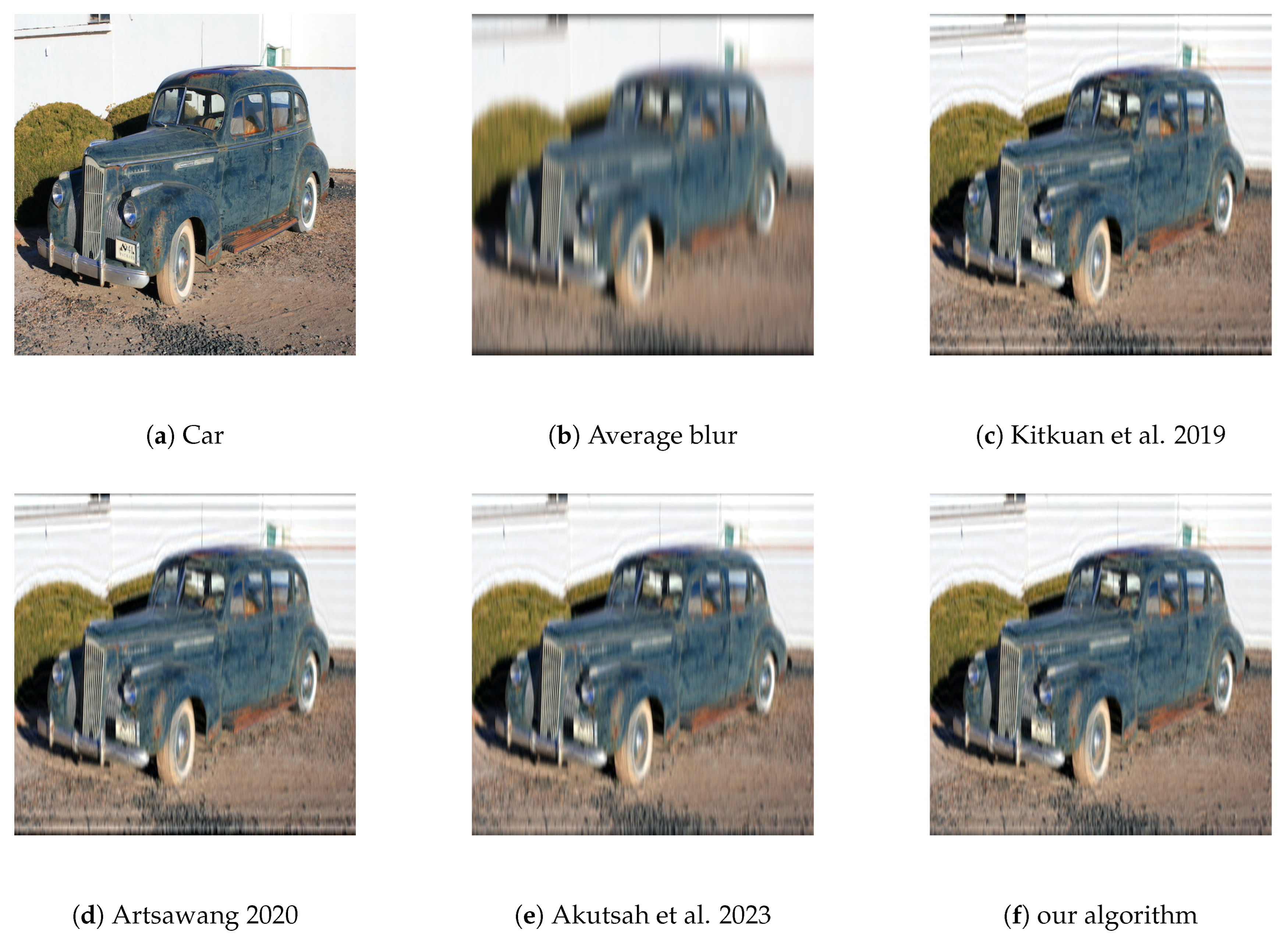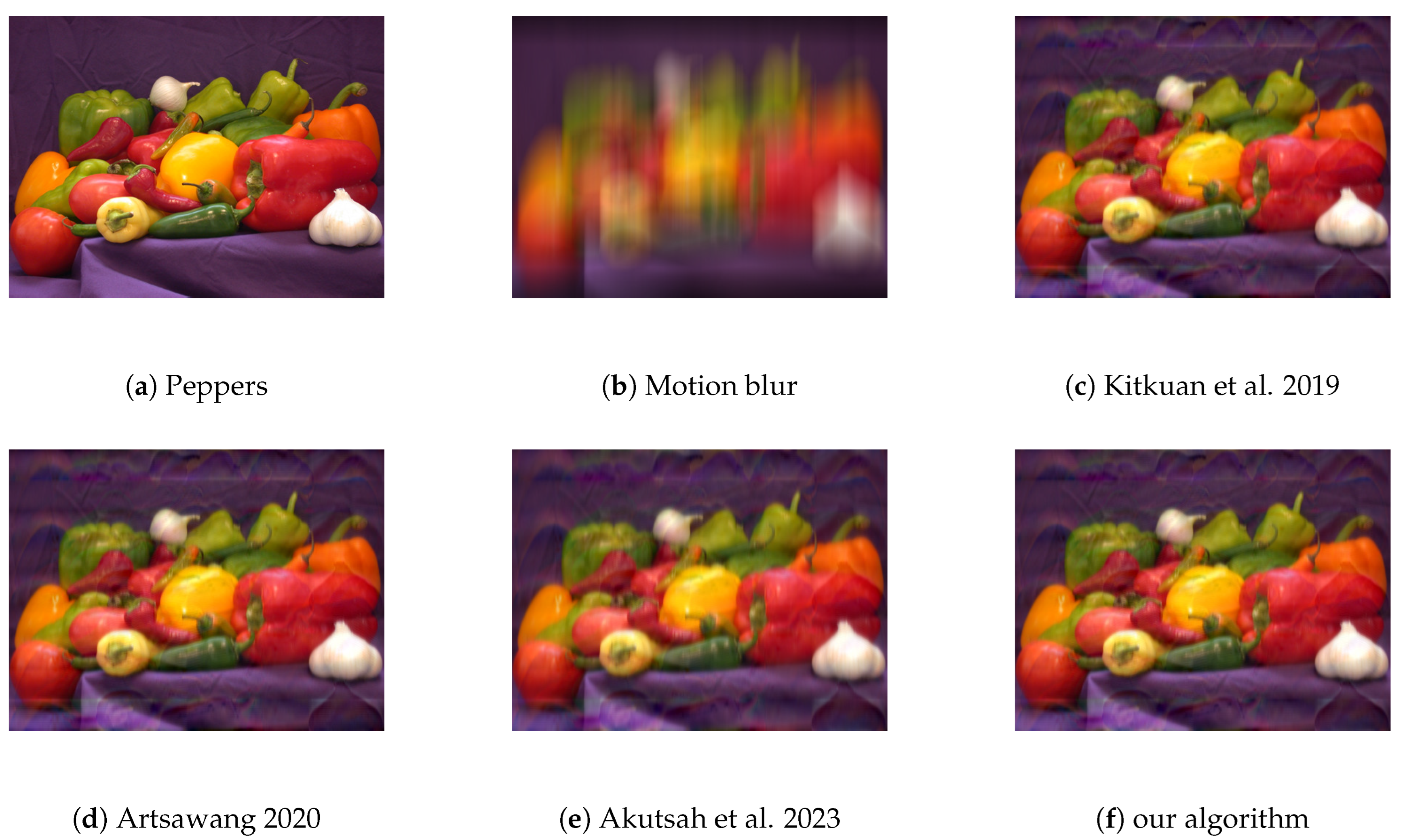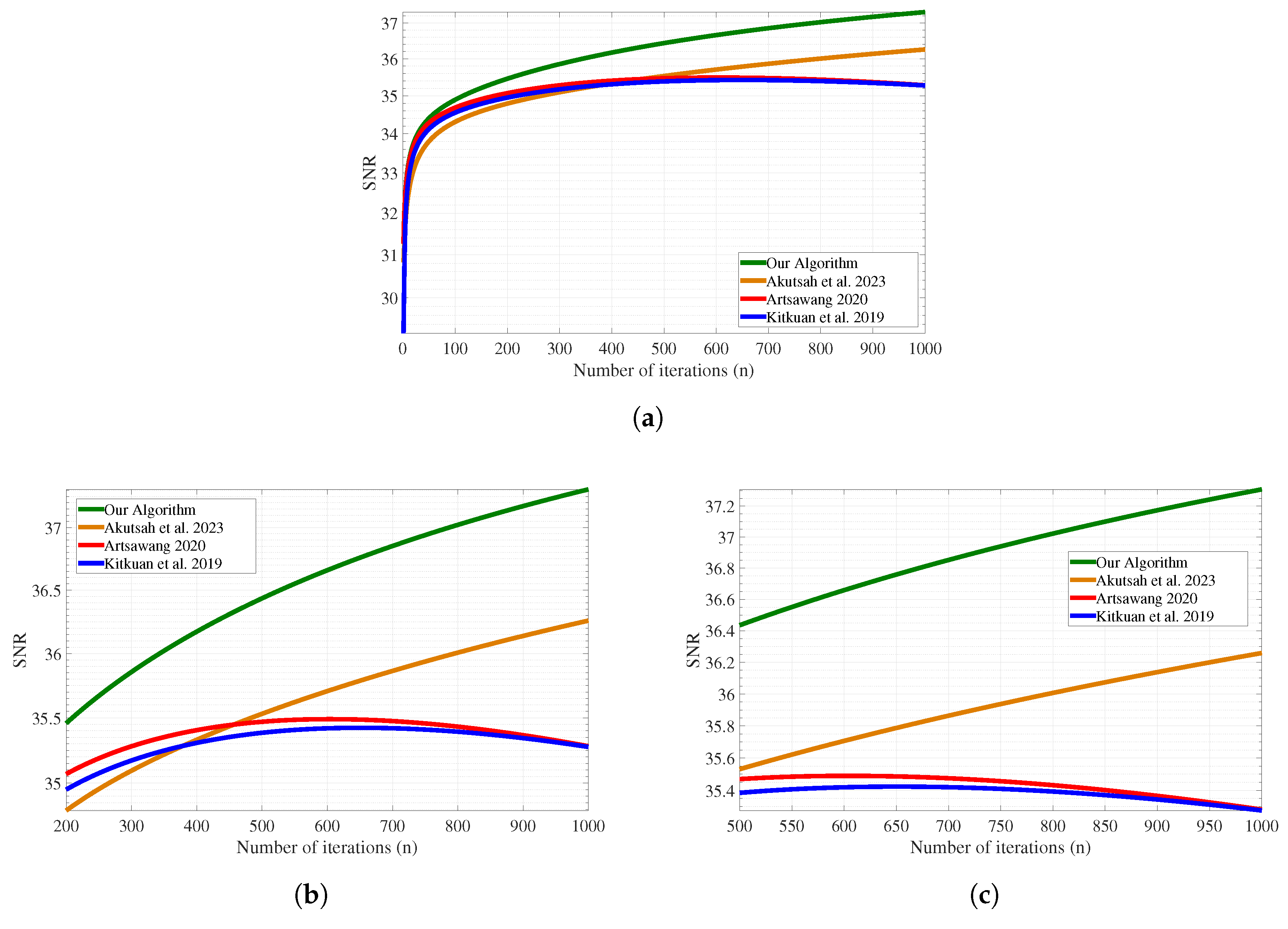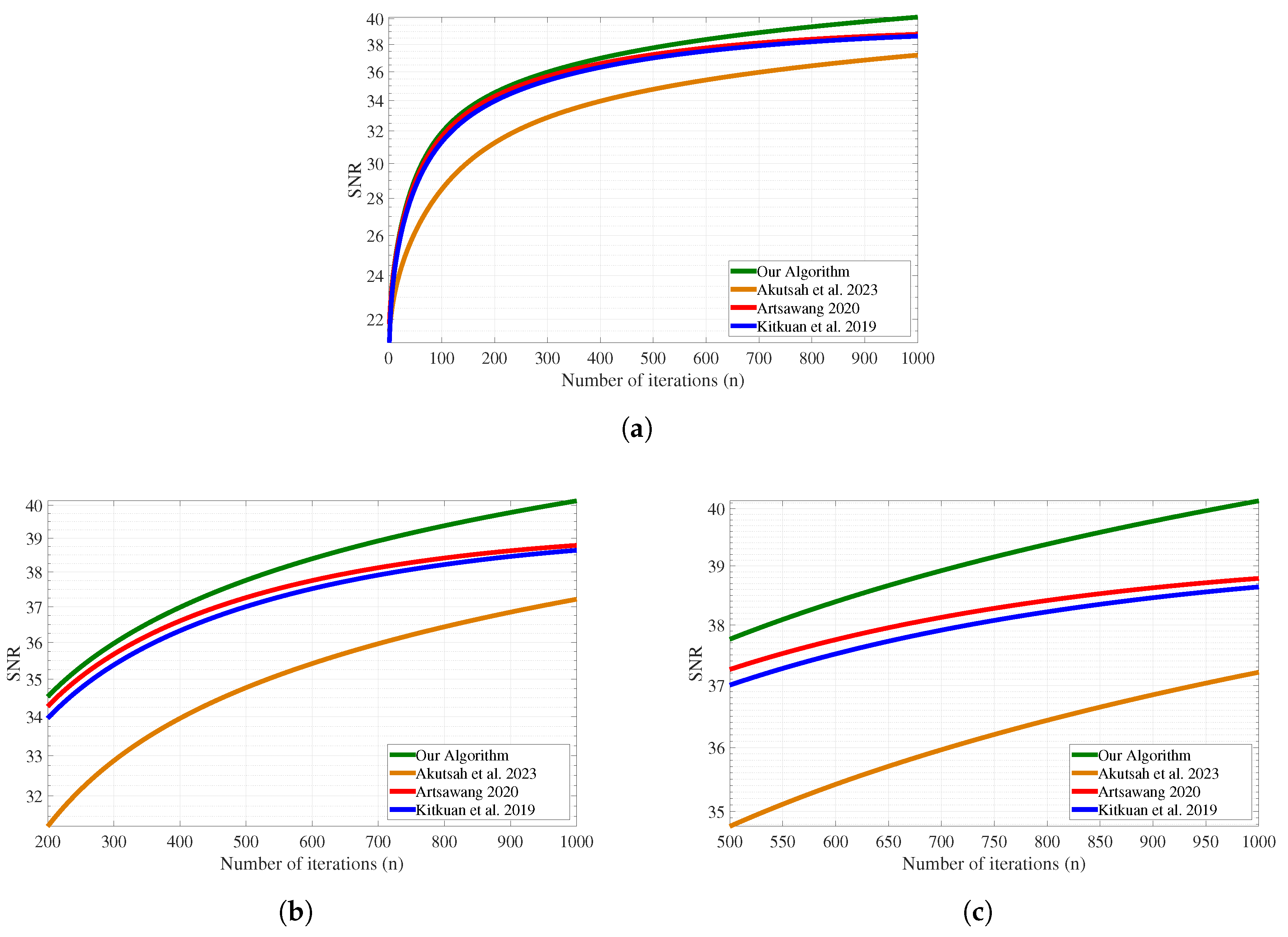1. Introduction
Let
H be a real Hilbert space with inner product
and associated norm
. Recall that a mapping
is said to be a strict pseudo-contraction if there exists
such that
In particular, it is well known that if
in (
1), then the mapping
T in (
1) is said to be a firmly nonexpansive mapping and the equivalent form of this mapping can be written as
Furthermore, if
in (
1), then the mapping
T in (
1) is called a nonexpansive mapping which we can view (
1) in this particular case as
, see [
1,
2] for more details.
We denote by
the set of all fixed points of
T. Let
C be a nonempty closed convex subset of
H. Then for every
there exists a unique
such that
and if we define
by
for all
then
is called the
metric projection (or nearest point projection) of
H onto
C, see [
3,
4,
5] more details.
Fixed Point Problem: The following is the fixed point problem for the mapping
T usually represented by:
Fixed point problems have found wide-ranging applications across various fields of mathematics, engineering, computer science, and other disciplines. These problems involve finding points in a function’s domain that remain unchanged after applying the function, making them essential in solving equations, optimization, economic equilibrium analysis, signal processing, control systems, machine learning, and fractal geometry. By providing a framework for iterative methods and stability analysis, fixed point problems offer powerful tools to tackle complex problems and uncover solutions in diverse areas of study.
The well known and important iterative algorithm for finding a solution of (
2) was proposed by Mann [
6] as follows:
where
is chosen from
Reich [
7] showed that if
T in (
3) is a nonexpansive with a fixed point and
satisfies some appropriate conditions, then (
3) converges weakly to a fixed point of
T. Later, Ishikawa [
8] relied on Mann’s ideas and proposed the following iterative method for a Lipschitzian pseudo-contraction in Hilbert spaces as follows:
Under certain suitable conditions of
C,
, and
, he was able to prove that (
4) converges strongly to a fixed point of
T. On the other hand, Halpern [
9] presented a new approach for finding a fixed point of a nonexpansive mapping
T which differs from Mann’s method by forcing one point of the vector to rest as follows:
where
is chosen from
It can be proved under some appropriate conditions that (
5) converges strongly to a fixed point of
T. After that, Moudafi [
10] developed a new iterative method which guarantees strong convergence that later came to be known as the viscosity approximation method by combining the Halpern iterative method with the contraction mapping. Many researchers studied the concept of viscosity method and then developed this method in many directions, see [
11,
12,
13,
14,
15] for more details. In 2019, Bot et al. [
16] modified and developed (
3) to induce strong convergence to a fixed point of a nonexpansive mapping without relying on the concept of viscosity approximation method. Their method is as follows:
when
and
are sequences chosen from
with suitable assumptions.
On the other hand, it is well known that the fixed point problem (
2) has the strong relationship with the
monotone inclusion problem which it can be written as follows:
where
is a multi-value operator. Indeed, for example, if
V is a multi-value maximal monotone operator, then
resolvent operator is a single-value and firmly nonexpansive mapping where
. Furthermore, for solving all solutions of (
7) is equivalent to solve all solutions of the fixed point problem of
or equivalently to say that
, where
is the set of all zero points of
V (see
Section 4 and [
3,
4] for more details).
In 1964, Polyak [
17] proposed several strategies to improve the convergence rate of iteration methods. These techniques include modifications to the classical iterative schemes, such as the use of variable relaxation parameters and acceleration techniques by using the inertial extrapolation term, that is,
where
is a sequence that satisfies appropriate conditions. Consequently, the inertial extrapolation has received attention and has been studied by many authors, see [
18,
19,
20,
21,
22,
23,
24,
25] more details. In 2019, Shehu [
26] proposed an algorithm that combines the inertial method, the Halpern method, and error terms to solve a fixed point of a nonexpansive mapping. Later, Kitkuan et al. [
27] employed the idea of inertial viscosity to find some solutions of monotone inclusion problems and apply to solve image restoration problems. Recently, Akutsah et al. [
28] introduced a new algorithm for finding a common fixed point of generalized nonexpansive mappings. Moreover, the fixed point problems have been studied in many aspects, see for instance [
29,
30,
31,
32,
33]. Inspired by Bot et al. [
16], Artsawang and Ungchittrakool [
25] introduced the inertial Mann-type algorithm for finding a fixed point of a nonexpansive mapping and applying to monotone inclusion and image restoration problems as follows:
where
are some appropriate sequences chosen from
.
Common Fixed Point Problem: the common fixed point problem for the mapping
S and
T is generally denoted by the following:
The common fixed point problem (
8) has many applications in various disciplines such as numerical analysis, optimization, dynamical systems, game theory, control theory, topology, computer science, and economics, etc. To approximate the common fixed points of two mappings, Das and Debata [
34] and Takahashi and Tamura [
35] generalized the Ishikawa iterative algorithm for mappings
S and
T as follows:
where
are some sequences chosen in
. Later, Khan and Fukhar-ud-din [
36] introduced and studied a scheme with errors for two nonexpansive mappings.
In 2007, Aoyama et al. [
37] introduced and studied Halpern iterative algorithm for a countable family of nonexpansive mappings and provided some important conditions on a countable family of nonexpansive mappings which later known as
AKTT condition to guarantee the convergence result to a common fixed point solution.
As mentioned above, all of these researches inspired and drove us to develop a new iterative algorithm, which is as follows:
Let
be any two countable families of nonexpansive mappings such that
. We propose the following algorithm:
for all
, where
with
,
and
are sequences in
and
is a sequence in
H.
Moreover, we can apply Equation (
9) as a tool to find a zero point solution of the sum of three monotone operators
as follows:
where
are some monotone operators on a Hilbert space
H,
W is
-cocoercive with parameter
, and
and
(see
Section 4 for more details). The problem (
10) can be viewed as a generalization of Artsawang and Ungchittrakool [
25] and Davis and Yin [
38]. It is useful to note the importance and association that (
10) can be rewritten to be some common fixed point problems of nonexpansive mappings (see
Section 4 for more details). For this reason, finding a solution of the monotone inclusion problem (
10), it can be applied the ideas of common fixed point problem and fixed point iterative algorithms to solve (
10). For practical applications, we can use by-products obtained from Equation (
9) to solve the image restoration problems. Furthermore, the effectiveness of our novel algorithm is substantiated by presenting numerical outcomes in different scenarios. These results conclusively establish that our algorithm outperforms its predecessor, as evidenced by the higher performance exhibited in the numerical analysis.
3. Main Results
In this section, we analyze the convergence of Equation (
9), starting with the boundedness property of the algorithm, as stated in the following lemma.
Assumption 1. Let , and be consistent with the following conditions:
- 1.
- 2.
- 3.
- 4.
- (a)
- (b)
and
- 5.
We have confirmed the validity of Assumption 1, as demonstrated in the following remark.
Remark 1. Let . We set , and for all . It is easy to see that the Assumption 1 is satisfied.
Lemma 6. Let be two countable families of nonexpansive mappings such that and let be generated by Equation (9). Let be a sequence in with such that Suppose 5. in Assumption 1 holds. Then is bounded. Proof. Let
. Then, let us consider
Using (
12) and (
13), we will have
Notice that
, we can apply Lemma 2 (1) to (
14) and then it shows that
is bounded. □
Lemma 7. Let be two countable families of nonexpansive mappings such that and let be generated by Equation (9). Let be a sequence in with such that Suppose 2., 3., 4b., and 5. in Assumption 1 hold and for any bounded subset Q of H, and satisfy AKTT condition. Then as . Proof. By using (
15), it can be observed that
where
and .
Moreover, we can find that
where
,
is some bounded set such that
, and
In the final step, by employing (
16) and (
17), it will obtain the following result
where
and
By using 2., 3., 4b., and 5. in Assumption 1 and AKTT conditon, we obtain that
. By applying Lemma 2 (2) to (
18), it yields that
as
□
Theorem 1. Let be two countable families of nonexpansive mappings such that and let be generated by Equation (9). Let be a sequence in with such that Suppose Assumption 1 holds and for any bounded subset Q of H, and satisfy AKTT condition. Let be defined by and for all and suppose that and and let . Then, the sequence strongly converges to . Proof. From Lemma 6, we have that
is bounded. By (
11) and (
13), it is not hard to see that
and
are also bounded. Let
. The first step let us consider the following inequality and equality.
and
By using Lemma 1 (1), we obtain the following inequality.
where
. Applying Lemma 1 (1), (
19) and (
20), we can see that
where
Since
, so (
23) yields that
On the other hand, let us consider
By using (
25) and (
24), it yields the following result.
Next, by employing (
24) and (
26), we obtain the following result.
By the virtue of (
27), it allows us to obtain
Similarly, the inequality (
26) yields the result below
It is not hard to see that (
22) can be rewritten to be the following
In order to prove that
converges strongly to
, it is enough to show that
Assume to a contrary that (
31) is not true, then there exists a real number
and a subsequence
of
such that
Since
is bounded on a Hilbert space
H, we obtain that there exists a subsequence
of
such that
as
. Therefore,
Notice that
, we obtain
as
Applying (
28), (
29) and Lemma 3, we obtain that
The characterization of metric projection via Lemma 4 yields that
which lead to a contradiction. For this reason, the inequality (
31) holds. So, it is unlocked and allows us to obtain
Applying Lemma 2 (2) to (
30), it can be concluded that
This complete the proof. □
Remark 2. The assumption of the sequence in Theorem 1 is verified, if we choose such that , where and
It is worth to mention that The implication of Theorem 1 can be applied for a wide range of the previous existing results as follows:
The first one, in the sense of constant sequences of nonexpansive mappings as in the followings:
Corollary 1. Let be two nonexpansive mappings such that and let be generated bywhere is a sequence in with such that Suppose Assumption 1 holds. Then, the sequence strongly converges to . Proof. If and for all where are nonexpansive mappings, then it is obvious that and satisfy AKTT condition for any nonempty subset . Moreover, and . Therefore, the desired result is obtained by the implication of Theorem 1. □
Lemma 8. Let be a nonexpansive mapping with . Define for all . Then the following statements hold:
- (i)
are nonexpansive mappings for all .
- (ii)
If with the property that , then .
- (iii)
If , then satisfies AKTT condition for any nonempty bounded subset Q of H.
Proof. It is not hard to verify the proof of (i). For the proof of (ii), let us consider
On the other hand, it is found that
Therefore, Lemma 8(ii) holds. For the proof of Lemma 8(iii), let
be a nonempty and bounded subset. Then, since
, it is not hard to see that the set
is also bounded. And then it can be observed that for any
,
This implies that
where
. Therefore,
This shows that Lemma 8(iii) is true. □
Corollary 2 ([
25]
). Let be a nonexpansive mapping such that and let be generated bywhere is a sequence in with such that Suppose that and are consistent with the following conditions: - (a)
and
- (b)
and
- (c)
Then, the sequence strongly converges to
Proof. First, it is not hard to verify that
where
and
. Indeed, from the third line of (
34), it is observed that
Setting for all and since , so we have On the other hand, the definition of and the condition (a) imply that satisfies (i)–(iii) of Lemma 8. Then, by applying Theorem 1, we have the desired result. □
Corollary 3 ([
16] Theorem 3
). Let be a nonexpansive mapping such that and let be generated by Suppose that are consistent with the following conditions:
- 1.
and
- 2.
and
Then, the sequence strongly converges to
Proof. By letting and for all in Corollary 2. Then, we obtain the desired result. □
4. Applications
This section focuses on exploring the potential uses of Equation (
9) and its by-products in specific cases from Equation (
9) to solve monotone inclusion problems.
Recall that the operator is said to be:
monotone if it satisfies for all .
κ-cocoercive if there exists such that for all
The set of all zeros of the operator W is denoted by
Let be the graph of a multivalued operator . Then, V is called:
monotone if for all , and implies that .
maximal monotone if is not properly contained in any graph of other multivalued monotone operator, that is, if is a multivalued monotone operator such that , then .
λ-strongly monotone if there exists such that for all .
The multivalued operator
which is defined by
is called the
resolvent operator associated with
V. It is well known that if
is maximal monotone and
, then
is single-valued and firmly nonexpansive. By employing
, the
Yosida approximation of
V is defined by
.
Let us consider the following monotone inclusion problem:
where
,
are maximal monotone operators and
is a
-cocoercive operator with
. For applying Equation (
9) to solve (
35), the important tool is as follows:
Proposition 1 ([
38], Proposition 2.1).
Let be two firmly nonexpansive operators and W be a κ-cocoercive operator with . Let . Then operatoris α-averaged with coefficient . In particular, the following inequality holds for all The following lemma provides a characterization of .
Lemma 9 (Fixed point encoding).
Let , be maximal monotone operators and be an operator. Suppose that Then,where Proof. Let
. Then,
. This implies that
and
such that
Next, we expect that
for some
. Let
and since
. This means that
. Moreover, it can be observed that
. It remains to show that
. Let us consider
This shows that and then .
On the other hand, let
Then, there exists
such that
Moreover, it can be observed that
This implies that
and by using some properties of Yosida approximation
of
U and
of
V, it yields that
By simple calculation, we have that and then
□
Assume that
and by employing (
33), then the following algorithm can be constructed for solving (
35) as follows:
for all
, where
and
.
Theorem 2. Let be two maximal monotone operators and be κ-cocoercive with . Suppose that , , and , that is, . Let be a sequence in with and and . Let and be generated by Equation (36). Assume that and the Assumption 1 holds. Then the following statements are true: - (A)
strongly converges to .
- (B)
strongly converges to .
Proof. (A): Let
be generated by Equation (
36). By Proposition 1, we obtain
S and
T are nonexpansive. By applying Corollary 1, we have the sequence
strongly converges to
as
.
(B): Notice that
and
as
, thus
as
. Since
is continuous, so
. By applying Lemma 9, we have that
and
. Then,
This shows that □
In Theorem 2, if we set , then for all . By applying Lemma 9, it yields where and . All of which leads to the following corollary.
Corollary 4. Let be a maximal monotone operator and a κ-cocoercive operator with and Let be generated by the followingfor all , where , , and with . Assume that the Assumption 1 holds and . Then, the sequence strongly converges to . 









